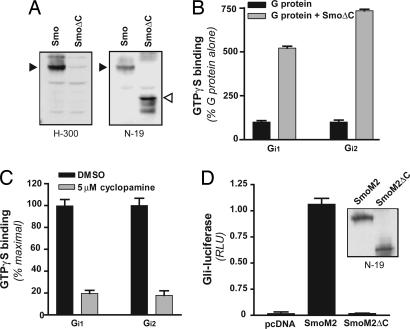Fig. 3.
The C-tail of Smo is required for activation of Gli but not Gi. (A) Membranes from Sf9 cells infected with recombinant baculoviruses for Smo and a C-tail-deleted mutant of Smo (SmoΔC) were subjected to SDS/PAGE (10 μg of protein per lane) and then, after transfer to nitrocellulose, probed with antibodies directed against the C-terminal (H300) or N-terminal (N19) aspects of Smo. Solid arrowheads denote the position of full-length Smo (86 kDa), and the empty arrowhead denotes the position of truncated Smo (62 kDa). (B) [35S]GTPγS binding was evaluated as described in Fig. 1 for two members of the Gi family, Gi1 and Gi2, expressed with (gray bars) or without (black bars) SmoΔC in Sf9 cells. Results shown are representative of three independent experiments performed in triplicate. (C) SmoΔC-stimulated binding of [35S]GTPγS to the G proteins was evaluated in the presence or absence of 5 μM cyclopamine as described in Fig. 1 for Smo. (D) NIH 3T3 cells were transfected with empty vector (pcDNA), SmoM2, or a C-tail-deleted mutant of SmoM2 (SmoM2ΔC) together with Gli (and Renilla) luciferase reporters, then assayed for luciferase activities 24 h thereafter, as described in Fig. 2. (Inset) SmoM2 and SmoM2ΔC express equivalently in HEK 293 cells (Western blot with N-19); expression in 3T3 cells was not high enough for detection.

